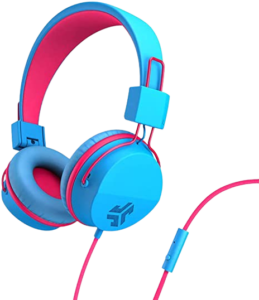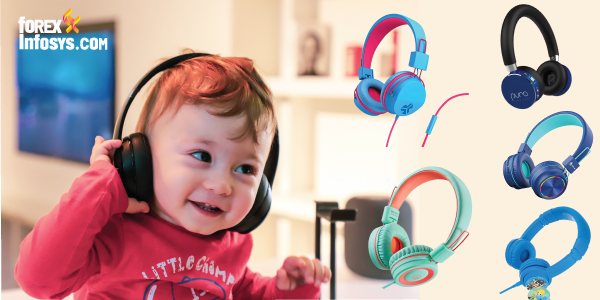Reduce noise exposure and safeguard hearing by choosing the best kids’ headphones
Our Favorites kids’ headphones: At a glance
- iClever BTH03 ($24 @ Amazon)
- Puro Sound Labs BT2200s ($99 @ Amazon)
- Noot Kids Headphones ($14 @ Amazon)
- ONANOFF BuddyPhones Explore+ (@ Amazon)
- JBuddies Studio Bluetooth Over-Ear Kids Headphones (@ Amazon)
How to pick the best kids’ headphones for your child
It’s crucial to get the right headphones for your kids because wearing the wrong ones could permanently harm their hearing. Children’s headphones must be included in parent’s tech kits.
These days, having a good set of children’s headphones is even more essential with remote learning and homeschooling. Purchasing headphones made specifically for children is a wise investment because they may be used on lengthy journey in trains or flights.
The issue is that airline-provided headphones are frequently slipped off because they aren’t made for little heads. Remember; Your child’s hearing may be endangered if you put adult headphones on their head.
What should the volume be restricted to kids’ headphones?
A child’s set of headphones shouldn’t, in our opinion, be any higher than 85 decibels (dB), even though Maxell and Sony sell sets for children that are 90dB. The maximum noise level that many auditory health organizations recommend is 85 dB.
Adult headphones typically reach their loudest level at 115 decibels. Experts caution that after just 15 minutes of daily listening at such volume, which is akin to a noisy train, you could suffer significant hearing loss.
A fantastic set of kid’s headphones includes:
- An effective volume limiter to safeguard kids’ delicate ears
- A good, comfortable fit for smaller heads
- Minimum noise leakage (the amount of sound that is audible outside of the headphones) Some kid-friendly fun in the design
We strongly advise against giving kids any in-ear headphones or earbuds to your kids. Don’t let kids wear your preferred headphones for extended periods of time just because they have a volume limit. Long-term use of headphones is not advised, even at 85dB.
Our Top Picks
1. iClever BTH03
The wireless technology, extended battery life, and comfortable design make the iClever BTH03 headphones among the best headphones for kids.
| Key Features: | Pros: | Cons: |
|
|
|
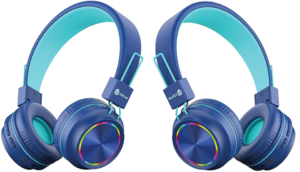

2. Puro Sound Labs BT2200s
Although the Puro Sound Labs BT2200 has a non-kid swagger, it boasts kid-friendly functions.
The BT2200 cans, which have a sophisticated appearance yet are made for children, have a sturdy aluminum shell and good headrest and on-ear cup padding.
| Key Features: | Pros: | |
|
|
|
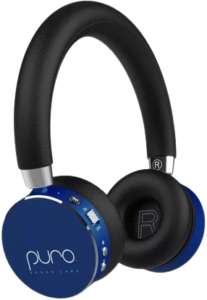

3. Noot Kids Headphones
The audio quality, kid-friendly design, and durability of the Noot K11 headphones make them some of the best headphones for children. Kids will quickly adopt these headphones as a necessity, and parents will be happy with their investment.
| Key Features: | Pros: | Cons: |
|
|
|
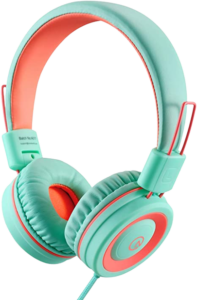

4. ONANOFF BuddyPhones Explore+
With its revolutionary design, enhanced ergonomics, broader, more comfortable headband, and new soft protein PU leather fabric, the BuddyPhones Explore+ is a generation ahead. To avoid permanent hearing loss, the volume of all sounds is restricted at 85 decibels. The BuddyJack audio splitter, a microphone, and call/playback buttons are all included on the detachable wire, which minimizes snagging.
| Key Features: | Pros: | Cons: |
|
|
|
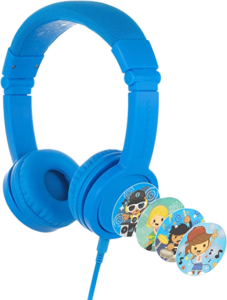
5. JBuddies Studio Bluetooth Over-Ear Kids Headphones
The JLab JBuddies Studio Wireless are a set of inexpensive children’s headphones that completely disregard the idea of pricing.
The brand-new 2020 JBuddies Studio offers Bluetooth convenience and wired connectivity options for use at home or on the move. JBuddies Studio’s on-ear Cloud FoamTM Cushions offer all-day comfort for work or school with a 24+ Hour battery life. Two children can view a movie together or listen to their favorite music with Shareport. Use a volume regulator to protect young hearing so that kids can listen to music that is 85 dB or lower, which is ideal for sensitive and developing ears. Kids can easily go from wired to wireless thanks to built-in controls and a microphone. Nothing to stress about.
| Key Features: | Pros: | |
|
|
|
